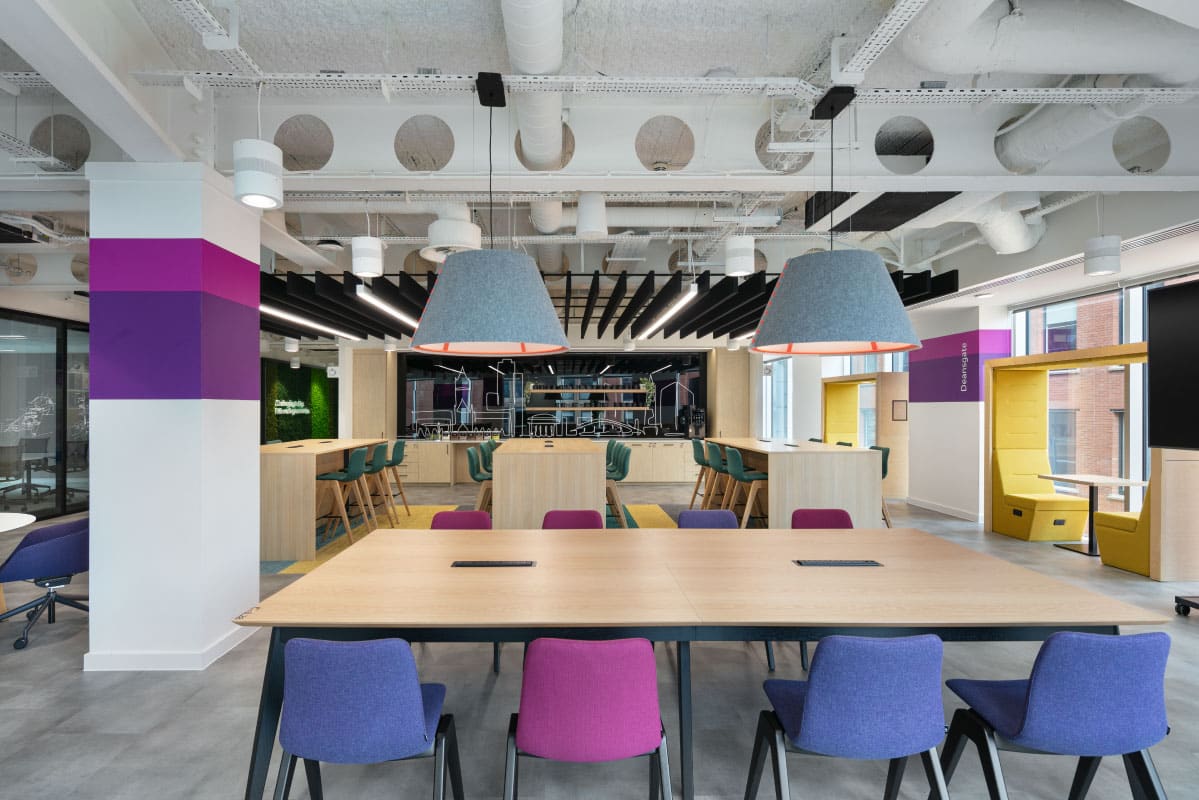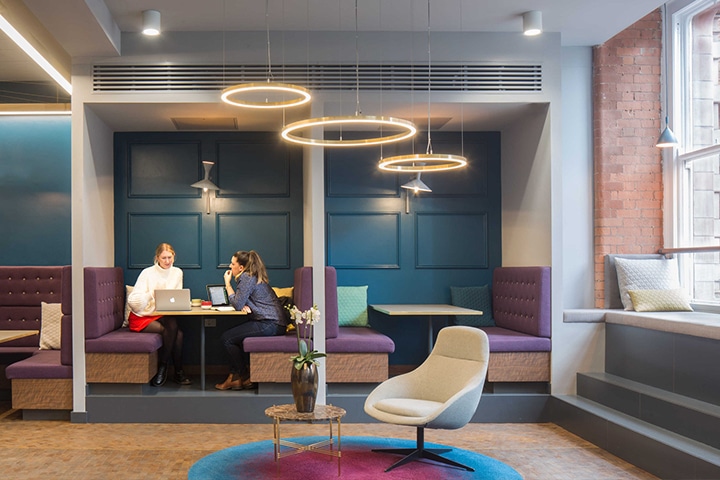Hybrid working signifies a deeper behavioural and cultural change
In recent years, hybrid working has skyrocketed in popularity – but what is a hybrid workplace and why has it become so important?
Hybrid working allows employees to work remotely and from a traditional office or company headquarters by rotating on set days each week or choosing a more flexible approach.
The role of a hybrid office is to seamlessly integrate the two ways of working, but this goes beyond intelligent office layout and design features. Hybrid working signifies a deeper behavioural and cultural change around how and where we work. As such, the traditional office set-up also needs to undergo an important transformation to become an effective and inspiring environment for colleagues to connect, collaborate, learn, and shape company culture.

The rise of hybrid working
The COVID-19 pandemic quickly necessitated remote working for many companies and industries worldwide, leading many businesses to the realisation that employees don’t need to be in the office all the time to work effectively. Hybrid working emerged as part of our ‘new normal’, offering employees a ‘best of both worlds’ solution that recognised the importance of face-to-face interaction and time in the office, and the freedom and flexibility that remote working can bring.
Research indicates that 72% of UK employers offer hybrid or fully remote work for their employees, with only 28% requiring full-time office-based work. A structured hybrid model (where employers specify how much time employees are expected to be in the office each week) remains the most popular solution, adopted by 44% of businesses.
However, the era of hybrid working demands that office spaces work harder. Since employees have proven that they can work effectively remotely, the office needs to offer something different to what they can get at home. It should be a welcoming and inspiring destination that employees want to spend time in. It also needs to maximise the less frequent face-to-face time colleagues have together to foster communication, collaboration, and a sense of belonging.
What are the benefits of a hybrid workplace?
While creating a hybrid workplace design that supports your business needs and brings the best out of your workforce is no simple task, doing so effectively brings numerous benefits, including:
Talent attraction and recruitment:
Hybrid working allows companies to broaden their talent pool and makes roles more attractive to candidates who cannot easily travel into an office, or are perhaps based further away.
Inclusivity and diversity in the workplace:
The need for diversity in the workplace is well documented, and offering more flexibility allows companies to cater for different needs and accommodate a wider range of people – and a greater range of skills, strengths, personalities and experiences.
Better work-life balance:
People appreciate employers that acknowledge and respect the demands and boundaries of their personal lives, allowing them to manage non-work related commitments in a way that works better for their family, or supports their wellbeing for example.
Employee retention:
Satisfied employees who feel their needs are respected and met are more likely to think positively toward their employer and less likely to move on.
Greater performance and productivity:
Employers are more likely to get the best out of their employees if they’re happy. Recent research found a link between happy workers and a 13% increase in productivity.
Minimising overheads:
Hybrid working means that growing businesses don’t always necessarily have to relocate to accommodate more employees, as it’s unlikely that everyone will be in the office at one time. Plus, there are lots of clever solutions available to make workspaces work harder without having to increase office footprint and associated overheads.
Learning and development:
In-person interaction is usually more effective for learning, as it offers employees the opportunity to work alongside colleagues and managers first-hand, and absorb knowledge from being in the office environment, observing conversations and processes.
Company culture:
A vibrant workplace environment buzzing with employees and interactions is a crucial part of building and shaping company culture.

What does a hybrid workplace look like?
The wide-ranging benefits that hybrid working can bring are significant, but how do you go about creating an effective office design for hybrid working?
Incorporating a range of different workplace settings is key. Gone are the days when traditional desk banks and several private meeting rooms were enough to accommodate employees in the workplace. You still need to cater for focus work and offer desks, quiet zones, booths, and dedicated private meeting spaces, but a hybrid workplace also needs collaboration spaces, solutions for meetings with virtual colleagues, social and breakout areas, and wellbeing spaces, with effective design features and digital technology to bring it all together. Here, we take a deeper look at some of the main considerations.

OPEN SPACE AND OPPORTUNITIES TO SOCIALISE
Our research shows that employees make the journey into their place of work mainly for the opportunity to connect with colleagues, collaborate, and feel part of the company culture. Yet, as the main reasons employees come into the office have shifted, so too must the work environment.
Hybrid office space should encourage interaction – both planned and chance encounters.
Consider how to foster these interactions to strengthen workplace connections in your office design.
Collaboration in the hybrid workplace can be encouraged with a range of different features: large round tables; standing desks, whiteboards or media walls to promote the visualisation and sharing of ideas, and creative brainstorm areas with comfortable and reconfigurable seating.
Communal kitchen space, coffee and bar facilities, sociable dining areas, games rooms and outdoor space are all effective at bringing people together and encouraging casual interactions away from formal work tasks to help foster deeper connections.
Creating spaces and opportunities in your workspace to encourage impromptu meetings can also bring benefits. Consider whether you have any underutilised space in communal areas or an area that doesn’t serve a specific purpose, and make use of casual, comfortable seating to create informal areas and foster serendipitous
WELLBEING
The pandemic firmly placed employee wellbeing in the spotlight as many people experienced isolation or struggled through challenging circumstances, and this remained an important consideration as people were able to return to the workplace.
Establishing and maintaining a positive culture in the hybrid workplace is important, and employee wellbeing forms a significant part of this. We’ve covered office design for wellbeing in more depth in this blog, but key considerations include:
Access to natural light – large windows, glass doors and skylights.
Ventilation and quality fresh air – if your office is located in a more urban or polluted area, consider investing in air conditioning or purifying technology.
Biophilia – recognising our innate desire to connect to nature, many wellbeing benefits can be realised by introducing plants, water features or other natural elements and forms into the workplace, including reducing stress levels and improving mood.
Temperature and lighting controls – allowing employees to change settings to create a comfortable environment conducive to productivity.
Calming colours and designs – a heavily branded workplace can be overstimulating, especially if it involves lots of bold colours and patterns. Calming, natural tones in blues and greens, and images of nature can be calming. Think about the effect you’re trying to create in different areas and zones throughout the workplace and choose colours to complement.


ACOUSTICS
Noise pollution is often a concern for companies looking to design a hybrid workplace, as the use of open-plan spaces is often promoted. You can create an effective hybrid office layout, which optimises acoustic comfort, with solutions like acoustic panels, room dividers, internal glazing, and biophilic elements or reconfigurable modular furniture to frame specific areas. Areas surrounding quiet zones can be muted with carpets, curtains and other sound-absorbent materials, or you can minimise these if you’re trying to create a ‘buzz’ and a social, informal atmosphere
‘FLOATING’ AND ADAPTABLE WORKPLACES
Many hybrid workplace models also incorporate some sort of ‘floating workplace’, which typically refers to a flexible workspace which isn’t fixed to a specific team or people. One way to offer this is through ‘hot desking’, where employees choose between any available workspace when they come into the office, which allows more flexibility and encourages different colleagues to connect and share ideas.
Alternatively, floating workspaces can accommodate employees who can’t commute to the office as easily or move between different locations, while allowing them to come together with colleagues or other professionals in a shared work environment so they can reap the social, connection and collaboration benefits in a way that’s still convenient for them.


DIGITAL AND TECH REQUIREMENTS
Integrating Essential Technology
A carefully considered integrated technology strategy is a crucial part of an effective hybrid office concept. Ensuring employees have the basic equipment they need to do their jobs comfortably and safely is the bare minimum – phones, laptops, chargers, monitors, stands, and a mouse and keyboard are the obvious basics, but this might vary between different roles or individuals. To ensure you’re providing what everyone needs, avoid making assumptions and conduct a thorough workplace needs assessment.
Supporting Remote Work Setups
While it’s not possible to control what an employee’s work set-up looks like at home, the CIPD suggests that employers, ‘consider what equipment or technology will support effective and healthy remote working, including the provision of office furniture or mobile devices’.
Enhancing Communication in Hybrid Workplaces
Communication in the hybrid workplace is crucial, to support the seamless communication between remote and office-based workers, and technology integration plays a key role in this. High-speed internet in all spaces is necessary, and meeting spaces need to be equipped with advanced digital conferencing facilities and interactive smartboards.
Improving Video Call Environments
Communicating via video calls was ideal when we were in our own homes, but it’s more difficult in a hybrid environment. The buzz of a busy office does not make ideal call conditions, and background noise can interfere with both sound quality and focus. Investing in high-quality video call technology, and better spaces to facilitate video calls, such as tech-enabled individual or team booths, can go a long way in improving this.
Facilitating Effective Group Meetings
For group meetings with a combination of remote and office-based workers, simple yet effective solutions like D-shaped tables are becoming increasingly popular. These allow in-person participants to have a good view of the remote attendee/s, while those dialling in feel like they have a seat at the table.
Managing Space Bookings
Another important consideration when designing the hybrid office is how you can effectively manage the booking of different spaces. Booking technology that can accessed via a smartphone provides a quick and easy way for employees to book the facilities they need in advance, including meeting spaces, individual pods or desks.
Building a hybrid workplace: next steps
While remote working offers ease, convenience and flexibility, employees still need in-person time with colleagues for connection, learning, collaboration, and culture. This is important now and will continue to be for the future of workplace design.
The first step in creating a hybrid office design is understanding what your employees need, and aligning these with the needs of your business, to create a truly effective strategy and design that delivers tangible business benefits.
Visit our case study page to view our latest hybrid workplace design projects, or get in touch to arrange a consultation with one of our friendly workplace experts.
ADT Workplace
The Workplace, Zebra Court, Greenside Way, Manchester M24 1UN
Opening hours: 9am-5:30pm
Email: info@adtworkplace.com
Call: 0161 655 0290





